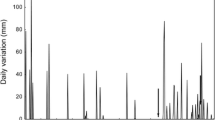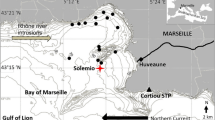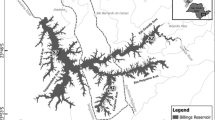Abstract
Protracted drought in southern Australia has degraded the system function of the Coorong estuary and intensified resource competition among forage fish species. The present study investigates the gut content, prey composition and dietary overlap of three forage fishes: smallmouth hardyhead (Atherinosoma microstoma), Tamar River goby (Afurcagobius tamarensis) and sandy sprat (Hyperlophus vittatus) influenced by environmental variation in the Murray Estuary and Coorong. The prey species identified in fish stomachs were dominated by crustaceans (amphipods, ostracods and harpacticoids), but nematodes and acanthocephalans were also common in all forage fishes. The diet of the sandy sprat and Tamar River goby highly overlapped (α = 0.8) in the Murray Estuary and all three forage fishes showed potential diet overlap (α ≥ 0.6) in the North Lagoon. Spatiotemporal variation of prey diversity was observed in smallmouth hardyhead while temporal variation of prey diversity was observed in sandy sprat and Tamar River goby. Overall, the prey abundance was temporally variable and predominantly regulated by salinity, pH, dissolved oxygen, water transparency and chlorophyll a in the Murray Estuary and Coorong. This study adds to our knowledge on dietary overlap and resource partitioning among small-bodied forage fishes mediated by environmental factors in the Murray Estuary and Coorong.




Similar content being viewed by others
References
Abrantes KG, Barnett A, Baker R, Sheaves M (2015) Habitat-specific food webs and trophic interactions supporting coastal-dependent fishery species: an Australian case study. Rev Fish Biol Fish 25:337–363
Alder J, Campbell B, Karpouzi V, Kaschner K, Pauly D (2008) Forage fish: from ecosystems to markets. Annu Rev Environ Resour 33:153–166
Amundsen PA, Gabler HM, Staldvik F (1996) A new approach to graphical analysis of feeding strategy from stomach contents data—modification of the Costello (1990) method. J Fish Biol 48:607–614
Anderson MJ (2001) A new method for non-parametric multivariate analysis of variance. Austral Ecol 26:32–46
Anderson MJ, Gorley RN, Clark KR (2008) PERMANOVA+ for PRIMER: guide to software and statistical methods. Plymouth, UK
Bachiller E, Irigoien X (2015) Trophodynamics and diet overlap of small pelagic fish species in the Bay of Biscay. Mar Ecol Prog Ser 534:179–198
Bayly I (1992) The non-marine Centropagidae (Copepoda: Calanoida) of the world. Guides to the identification of the Macroinvertebrates of the continental waters of the world. SPB Academic Publishing, Amsterdam
Becker A, Laurenson LJ (2008) Seasonal and diel comparisons of the diets of four dominant fish species within the main channel and flood-zone of a small intermittently open estuary in South-Eastern Australia. Mar Freshw Res 58:1086–1095
Bice CM, Furst D, Lamontagne S, Oliver RL, Zampatti BP, Revill A (2016) The influence of freshwater discharge on productivity, microbiota community structure and trophic dynamics in the Murray estuary: evidence of freshwater derived trophic subsidy in the sandy. Goyder Institute for Water Research Technical Report Series No. 15/40. Adelaide, South Australia
Boeuf G, Payan P (2001) How should salinity influence fish growth? Comparative Biochemistry and Physiology Part C: Toxicology & Pharmacology 130:411–423
Brookes JD, Aldridge KT, Ganf G, Paton D, Shiel R, Wedderburn S (2009) Environmental Watering for Food Webs in The Living Murray Icon Sites — A literature review and identification of research priorities relevant to the environmental watering actions of flow enhancement and retaining floodwater on floodplains. Report No. 11/12. Murray-Darling Basin Authority (MDBA)
Brookes JD, Aldridge KT, Bice CM, Deegan B, Ferguson GJ, Paton DC, Sheaves M, Ye Q, Zampatti BP (2015) Fish productivity in the lower lakes and Coorong, Australia, during severe drought. Trans R Soc S Aust 139:189–215
Cantanhêde G, Fugi R, Hahn N (2009) Variation in prey selection of a piscivorous fish after the impoundment of a neotropical reservoir: prey size and type. J Fish Biol 75:75–86
Chesson J (1978) Measuring preference in selective predation. Ecology 59(2):211–215
Clarke KR, Gorley RN (2006) PRIMER v6: User Manual/Tutorial. Primer-E, Plymouth
Clarke KR, Warwick RM (2001) Change in marine communities: an approach to statistical analysis and interpretation. Primer-E Ltd, Plymouth
Costello MJ (1990) Predator feeding strategy and prey importance: a new graphical analysis. J Fish Biol 36:261–263
Costello M, Elliott M, Thiel R (2002) Endangered and rare species. In: Elliott M, Hemingway K (eds) Fishes in Estuaries. Blackwell Publishing Ltd, UK, pp 217–265
D'Aguillo M, Harold A, Darden T (2014) Diet composition and feeding ecology of the naked goby Gobiosoma bosc (Gobiidae) from four western Atlantic estuaries. J Fish Biol 85:355–373
Day J Jr, Hall C, Kemp W, Yáñez-Arancibia A (1989) Estuarine ecology. John Wiley & Sons, New York
De DP, Geddes M (1980) Seasonal fauna of ephemeral saline lakes near the Coorong lagoon, South Australia. Mar Freshw Res 31:677–699
Deegan BM, Lamontagne S, Aldridge KT, Brookes JD (2010) Trophodynamics of the Coorong: spatial variability in food web structure along a hypersaline coastal lagoon. CSIRO: Water for a Healthy Country National Research Flagship, Cenbera
Dinh QM, Qin JG, Dittmann S, Tran DD (2016) Seasonal variation of food and feeding in burrowing goby Parapocryptes serperaster (Gobiidae) at different body sizes. Ichthyol Res 2016:1–11. doi:10.1007/s10228-016-0553-4
Dittmann S, Brown E, Navong N, Beyer K, Silvester L, Baggalley S, Keuning J (2012) Macrobenthic invertebrate survey 2011–12: lower lakes, Coorong and Murray mouth icon site. Report for the Department for Water and Murray-Darling Basin Authority Report, South Australia
Dittmann S, Baring R, Baggalley S, Cantin A, Earl J, Gannon R, Keuning J, Mayo A, Navong N, Nelson M (2015) Drought and flood effects on macrobenthic communities in the estuary of Australia's largest river system. Estuar Coast Shelf Sci 165:36–51
Dolbeth M, Martinho F, Leitão R, Cabral H, Pardal M (2008) Feeding patterns of the dominant benthic and demersal fish community in a temperate estuary. J Fish Biol 72:2500–2517
Eriksson SP, Wennhage H, Norkko J, Norkko A (2005) Episodic disturbance events modify predator–prey interactions in soft sediments. Estuar Coast Shelf Sci 64:289–294
Fjøsne K, Gjøsæter J (1996) Dietary composition and the potential of food competition between 0-group cod (Gadus morhua L.) and some other fish species in the littoral zone. ICES J Mar Sci 53:757–770
Gaughan D, Potter I (1997) Analysis of diet and feeding strategies within an assemblage of estuarine larval fish and an objective assessment of dietary niche overlap. Fish Bull 95:722–731
Gaughan D, Fletcher W, Tregonning R (1996) Spatial and seasonal distribution of eggs and larvae of sandy sprat, Hyperlophus vittatus (Clupeidae), off South-Western Australia. Mar Freshw Res 47:971–979
Geddes MC (2005) The ecological health of the North and South Lagoons of the Coorong in July 2004. Report No. RD03/0272–2. Department of Water, Land and Biodiversity Conservation, South Australian Research and Development Institute (SARDI Aquatic Sciences)
Geddes M, Francis J (2008) Trophic ecology pilot study in the river Murray estuary at pelican point. South Australian Research and Development Institute (SARDI Aquatic Sciences) Report:F2007/001193–F2007/001191
Geddes M, Shiel R, Francis J (2016) Zooplankton in the Murray estuary and Coorong during flow and no-flow periods. Trans R Soc S Aust 140:74–89
Giatas GC, Q Ye (2015) Diet and trophic characteristics of mulloway (Argyrosomus japonicas), congollis (Pseudaphritis urvillii) and Australian salmon (Arripis truttaceus and A. trutta) in the Coorong. Report No. F2015/000479–1. South Australian Research and Development Institute (SARDI Aquatic sciences)
Gillanders BM, Elsdon TS, Halliday IA, Jenkins GP, Robins JB, Valesini FJ (2011) Potential effects of climate change on Australian estuaries and fish utilising estuaries: a review. Mar Freshw Res 62:1115–1131
Hamond R (1971) The Australian species of Mesochra (Crustacea: harpacticoida), with a comprehensive key to the genus. Aust J Zool 19:1–32
Hamond R (1973) The harpacticoid copepods (Crustacea) of the Saline Lakes in Southeast Australia: with special reference to the Laophontidae. Australian Museum
Herman PM, Heip CH (1999) Biogeochemistry of the MAximum TURbidity zone of estuaries (MATURE): some conclusions. J Mar Syst 22:89–104
Higginson AD, Ruxton GD (2015) Foraging mode switching: the importance of prey distribution and foraging currency. Anim Behav 105:121–137
Hossain A, Ye Q, Leterme S, Qin J (2016) Spatial and temporal changes of three prey-fish assemblage structure in a hypersaline lagoon: the Coorong, South Australia. Mar Freshw Res. doi.org/10.1071/MF15212
Humphries P, Potter I (1993) Relationship between the habitat and diet of three species of atherinids and three species of gobies in a temperate Australian estuary. Mar Biol 116:193–204
Hyslop E (1980) Stomach contents analysis—a review of methods and their application. J Fish Biol 17:411–429
Ivlev V (1961) Experimental ecology of the feeding of fishes. Yale University Press, New Haven, USA
Jendyk J, Hemraj DA, Brown MH, Ellis AV, Leterme SC (2014) Environmental variability and phytoplankton dynamics in a south Australian inverse estuary. Cont Shelf Res 91:134–144
Keller W, Yan N, Somers K, Heneberry J (2002) Crustacean zooplankton communities in lakes recovering from acidification. Can J Fish Aquat Sci 59:726–735
Khan TA (2003) Limnology of four saline lakes in western Victoria. Australia: I Physico-chemical parameters Limnologica 33:316–326
Langton R (1982) Diet overlap between Atlantic cod, Gadus morhua, silver hake, Merluccius bilinearis, and fifteen other Northwest Atlantic finfish. Fish Bull 80:745–759
Leterme SC, Prime E, Mitchell J, Brown MH, Ellis AV (2013) Diatom adaptability to environmental change: a case study of two Cocconeis species from high-salinity areas. Diatom Research 28:29–35
Leterme SC, Allais L, Jendyk J, Hemraj DA, Newton K, Mitchell J, Shanafield M (2015) Drought conditions and recovery in the Coorong wetland, South Australia in 1997–2013. Estuar Coast Shelf Sci 163:175–184
Lui LC (1969) Salinity tolerance and osmoregulation of Taeniomembers microstomus (Gunther, 1861)(Pisces: Mugiliformes: Atherinidae) from Australian salt lakes. Mar Freshw Res 20:157–162
Marques SC, Pardal M, Pereira M, Gonçalves F, Marques J, Azeiteiro U (2007) Zooplankton distribution and dynamics in a temperate shallow estuary. Hydrobiologia 587:213–223
Molsher RL, Geddes MC, Paton DC (1994) Population and reproductive ecology of the small-mouthed hardyhead Atherinosoma microstoma (Günther)(Pisces: Atherinidae) along a salinity gradient in the Coorong, South Australia. Trans R Soc S Aust 118:207–216
Moyle PB, Cech J (2004) An introduction to ichthyology. Pearson Prentice Hall, Upper Saddle River, NJ 07458
Munday PL, Jones GP, Caley MJ (2001) Interspecific competition and coexistence in a guild of coral-dwelling fishes. Ecology 82:2177–2189
Noell CJ, Ye Q, Short DA, Bucater LB, Wellman NR (2009) Fish assemblages of the Murray Mouth and Coorong region, South Australia, during an extended drought period. CSIRO: Water for a Healthy Country National Research Flagship and South Australian Research and Development Institute (Aquatic Science), Adelaide, South Australia
Nunn A, Tewson L, Cowx I (2012) The foraging ecology of larval and juvenile fishes. Rev Fish Biol Fish 22:377–408
Oscoz J, Leunda PM, Campos F, Escala MC, Miranda R (2005) Diet of 0+ brown trout (Salmo trutta L., 1758) from the river Erro (Navarra, north of Spain). Limnetica 24:319–326
Paton D (2010) At the end of the river: the Coorong and lower lakes. ATF Press, Hindmarsh, South Australia
Paturej E, Gutkowska A (2015) The effect of salinity levels on the structure of zooplankton communities. Arch Biol Sci:12–12
Platell M, Potter I (2001) Partitioning of food resources amongst 18 abundant benthic carnivorous fish species in marine waters on the lower west coast of Australia. J Exp Mar Bio Ecol 261:31–54
Prince J, Potter I, Lenanton R, Loneragan N (1982) Segregation and feeding of atherinid species (Teleostei) in south-western Australian estuaries. Mar Freshw Res 33:865–880
Ringwood AH, Keppler CJ (2002) Water quality variation and clam growth: is pH really a non-issue in estuaries? Estuaries 25:901–907
Rogers P, Ward T (2007) Life history strategy of sandy sprat Hyperlophus vittatus (Clupeidae): a comparison with clupeoids of the indo-Pacific and southern Australia. J Appl Ichthyol 23:583–591
Schapira M, Buscot M-J, Pollet T, Leterme SC, Seuront L (2010) Distribution of picophytoplankton communities from brackish to hypersaline waters in a south Australian coastal lagoon. Saline Syst 6:2–15
Shiel RJ (1995) A guide to identification of rotifers, cladocerans and copepods from Australian inland waters. Co–operative Research Centre for Freshwater Ecology, Canberra
Smirnov NN, Timms B (1983) A revision of the Australian Cladocera (Crustacea). Records of the Autralian Museum, Supplements 1:1–132
Springer AM, Speckman SA (1997) forage fish is what? Summary of the Symposium, in Forage fishes in marine ecosystems, Proceedings of the International Symposium on the Role of Forage Fishes in Marine Ecosystems. Report No. 97–01. Fairbanks, University of Alaska, Alaska Sea Grant College Program, p. 773–805
Taylor MD, Fielder DS, Suthers IM (2006) Spatial and ontogenetic variation in the diet of wild and stocked mulloway (Argyrosomus japonicus, Sciaenidae) in Australian estuaries. Estuar Coasts 29:785–793
Vehmaa A, Brutemark A, Engström-Öst J (2012) Maternal effects may act as an adaptation mechanism for copepods facing pH and temperature changes. PLoS One 7:e48538
Ward AJ, Webster MM, Hart PJ (2006) Intraspecific food competition in fishes. Fish Fish 7:231–261
Webster IT (2010) The hydrodynamics and salinity regime of a coastal lagoon–the Coorong, Australia–seasonal to multi-decadal timescales. Estuar Coast Shelf Sci 90:264–274
Wedderburn S, Bice C, Barnes T (2014) Prey selection and diet overlap of native golden perch and alien redfin perch under contrasting hydrological conditions. Aust J Zool 62:374–381
Wedderburn SD, Bailey CP, Delean S, Paton DC (2016) Population and osmoregulatory responses of a euryhaline fish to extreme salinity fluctuations in coastal lagoons of the Coorong, Australia. Estuar Coast Shelf Sci 168:50–57
Whitfield AK (1999) Ichthyofaunal assemblages in estuaries: a south African case study. Rev Fish Biol Fish 9:151–186
Williams WD (1981) The limnology of saline lakes in western Victoria. Hydrobiologia 81:233–259
Williams WD (1998) Salinity as a determinant of the structure of biological communities in salt lakes. Hydrobiologia 381:191–201
Woodland RJ, Secor DH (2011) Differences in juvenile trophic niche for two coastal fish species that use marine and estuarine nursery habitats. Mar Ecol Prog Ser 439:241–254
Xie S, Cui Y, Zhang T, Li Z (2000) Seasonal patterns in feeding ecology of three small fishes in the Biandantang Lake, China. J Fish Biol 57:867–880
Ye Q, Bucater L, Short D, Earl J (2012) Coorong fish condition monitoring 2008–2010: Population and recruitment status of the black bream (Acanthopagrus Butcheri) and greenback flounder (Rhombosolea Tapirina). South Australian Research and Developement Institute (Aquatic Sciences), Adelaide. SARDI Publication No. F2011/000331–2. SARDI Research Report Series No. 572.nn55 pp.
Zampatti BP, Bice CM, Jennings PR (2010) Temporal variability in fish assemblage structure and recruitment in a freshwater-deprived estuary: the Coorong, Australia. Mar Freshw Res 61:1298–1312
Acknowledgements
We would like to thank David Short and Neil Wellman for their assistance in the field. This project was carried out under a Flinders University Animal Welfare Committee Project E394. This project was partially supported by Flinders International Postgraduate Research Scholarship and conducted in conjunction with the SARDI project: Coorong fish intervention monitoring 2013/14. The monitoring program was part of the South Australian Government’s Murray Futures program, funded by the South Australian Government’s Water for the Future initiative, and supported by the Living Murray program. The Living Murray is a joint initiative funded by the New South Wales, Victorian, South Australian, ACT and Commonwealth governments, coordinated by the Murray–Darling Basin Authority.
Author information
Authors and Affiliations
Corresponding author
Rights and permissions
About this article
Cite this article
Hossain, M.A., Hemraj, D.A., Ye, Q. et al. Diet overlap and resource partitioning among three forage fish species in Coorong, the largest inverse estuary in Australia. Environ Biol Fish 100, 639–654 (2017). https://doi.org/10.1007/s10641-017-0592-3
Received:
Accepted:
Published:
Issue Date:
DOI: https://doi.org/10.1007/s10641-017-0592-3




